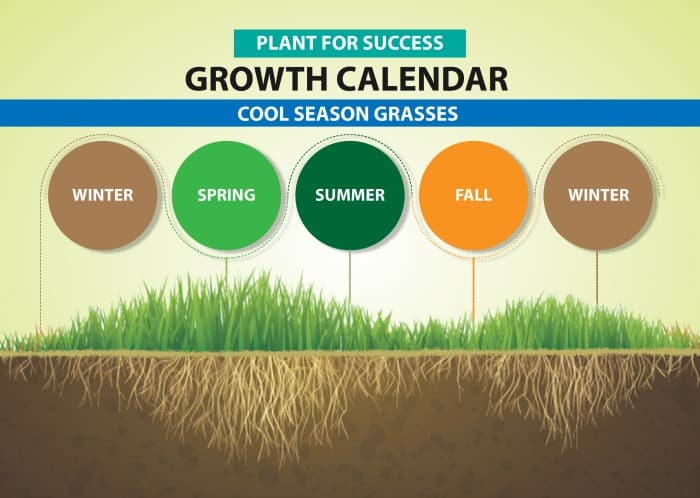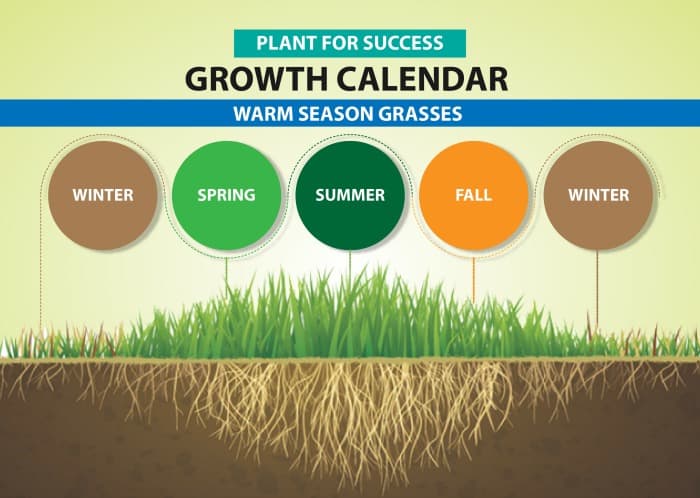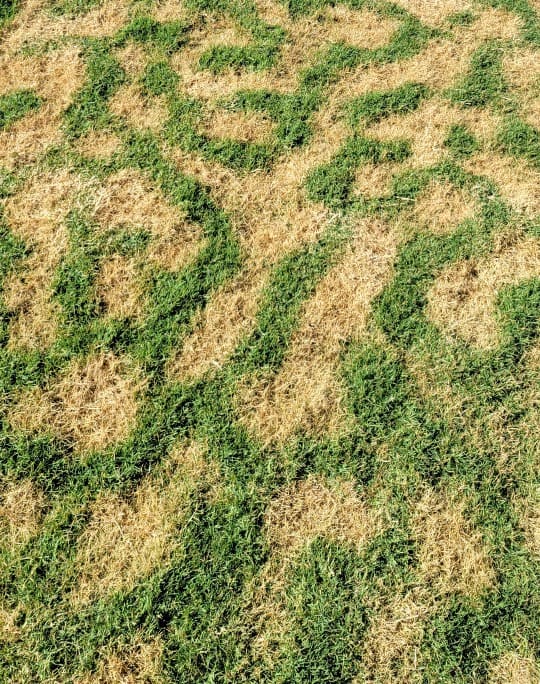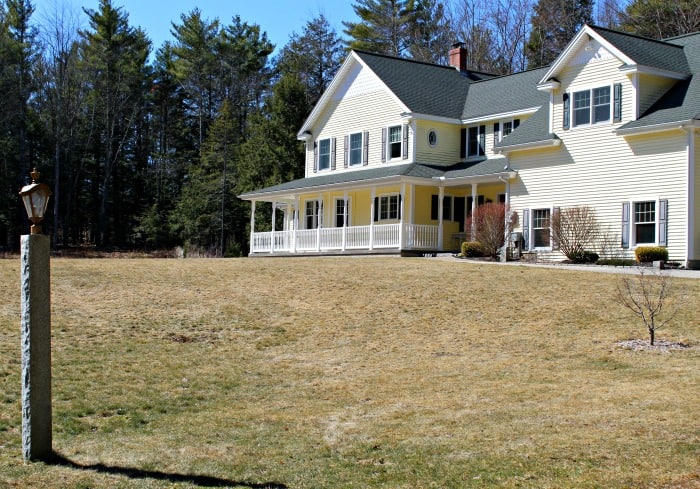What Is Dormant Grass
Dormancy is a naturally occurring period that both cool season and warm season grasses experience, in an effort to conserve water and nutrients. It’s a period of rest during a time of stress which is usually brought on by cold temperatures during the winter, or dry conditions during the summer.
Dormancy In Cool Season Grass
Take a look at the growth chart of a cool season lawn:

There are 2 times of the year when your cool season lawn can experience dormancy. The first time is during the winter months, which is pretty much a guaranteed period of dormancy for cool season grasses. The second dormancy period is during the hot summer months, which can be avoided if you can properly irrigate your lawn.
Winter Dormancy In Cool Season Grass
Once soil temps consistently fall to below 45 degrees, your cool season lawn will enter winter dormancy. At this point the season is officially over and it’s time to wait until next spring.
Leading up to the winter dormancy period, mow your lawn a little shorter on the last mow of the season and apply a high nitrogen fertilizer as a winterizer fertilizer. The nitrogen applied here will be stored and used next spring.
Once your lawn is dormant, stay off of it as much as possible, especially if there is frost. The crown portion of the grass is right at the surface and if that crown gets damaged it won’t grow back next spring. Also, you may notice your lawn turn brown the longer it is dormant. This is normal. The grass isn’t dead, you will see it green up in the spring.
Summer Dormancy In Cool Season Grass
The transition from spring to summer is another drastic change in your cool season lawn, especially if you don’t irrigate. Hot, dry weather will cause your grass to slow down. As summer progresses you’ll notice your lawn doesn’t grow as much and you’ll likely be mowing less. You may also notice dry spots and if dry conditions persist, your lawn will start to turn brown as it enters summer dormancy.
Before your lawn shows signs of stress, start to dial back on nitrogen fertilizers. Instead you want to increase potassium to help prepare your lawn for this part of the year where it will be stressed the most. Stress Blend 7-0-20 is a great way to cut back on nitrogen and increase potassium.
Increase your mowing height and do whatever you can to water your lawn to keep it alive if there are prolonged dry periods. Even if you can’t irrigate enough to keep it fully green at least do what you can to give roots enough water to survive. Proper irrigation can be a challenge especially if you’re on well water or in an area where there are watering restrictions but doing what you can to string your grass along during the summer will pay off big in the fall.
Dormancy In Warm Season Grass
For warm season lawns, the hot summer months is when grass thrives. For this reason there is really only one dormancy period for warm season lawns. This period is from fall when soil temps dip below 55 degrees, through late winter when soil temps increase above 55 degrees.
Take a look at the growth chart for Warm Season Lawns:

Winter Dormancy In Warm Season Grass
In the winter your warm season goes dormant on top but in the soil the roots are still active. This means the roots will still be looking for water since they are still awake. You don’t have to water too often but be aware of prolonged dry periods. Since your lawn is dormant and brown on top you don’t have the visual cue that tells you your lawn needs water. Take a small probe of the soil every one in awhile to see if there is moisture in it. If it is dry and you have the ability to irrigate then do so.
Also, leading up to the dormant winter months, feed your lawn potassium and cut back on nitrogen. Stress Blend 7-0-20 makes a great late season fertilizer when your lawn is going dormant. Lastly, you’ll want to make sure you apply a late season pre emergent such as Prodiamine 0-0-7 to block winter weeds from growing in your warm season lawn.
How Can You Tell if Grass Is Dormant or Dead?
Dormant grass can cause a lot of panic since its tan or brown color closely resembles dead grass, or dying grass. But before you panic, make the following observations and perform the following tests:
1. Take a close look
Get up really close to your grass. For cool season grass look at the crown. The crown is the part of the grass that comes out of the soil. You should see some tiny green growth in the crown of the grass once soil temps warm in the spring. Last years grass blades may be brown, but inside the crown should be green as long as soil temps are warm enough. For warm season lawns check the runners along the surface of your lawn. You should see little green growth forming when soil temps warm in the spring.
2. Irrigate
If you have the option to irrigate your lawn then do so. If you’re having drought conditions in the summer, you’ll see the lawn get some of its color back as it gets a much needed dose of water.
3. Observe the consistency
Is the brown grass patchy, or uniform and widespread throughout your lawn?
During the winter dormancy period, dormant grass is usually pretty consistent in color throughout the lawn, or through large sections of your lawn.
For summer dormancy in cool season grass you might see some patchiness since there could be areas of your lawn that tend to dry out quicker due to sunlight exposure and soil makeup. If you have an irrigation system you could have a couple areas of poor coverage and therefor those areas might show signs of dormancy as well.
Overall though, dormancy in cool season grasses tends to be uniform, especially during the winter dormancy period.
But for warm season grasses such as Bermuda and St. Augustine, you can get some real funky patterns for the brief periods heading into winter dormancy and heading back out of dormancy in the spring. Don’t be alarmed if you see some of these crazy patterns. Check out this pic of a lawn with Bermuda Grass heading into dormancy:

Even though these patterns are irregular, they should be seen consistently throughout your lawn.
4. Think of temperature and weather conditions
If you see your lawn turning brown think about what the weather conditions have been recently. Has it been dry during the summer months? Are you coming out of the cold winter months? Is it late fall and temperatures have been really cold, maybe even some mornings of frost? These are all conditions that can cause your grass to go dormant, and therefor will explain the discoloration.
Check Out These Posts Next
The Importance of Soil Temps in Your Lawn
Winterizer Fertilizer: Everything You Need to Know
Follow Me
Join my free email list!
Plus, follow me on Facebook, Instagram, and Pinterest.



Thanks for the info. I’m always shocked at how my cool season lawn looks dead after a long winter. But like you said, it always uniform and eventually spring back. I might give organic fertilizers a shot!
thanks for commenting Dan! I’d love for you to give organic fertilizers a shot. They are so much better for building healthy soil and releasing nitrogen slowly and evenly.
Really informative. I never thought to water warm season grass during the winter. Some winters we have little snow for long periods. Very good point indeed!
Thanks very much Alan, happy to hear you found it informative!
I live around Austin and we have little freezes. I wanted to water the roots, bit I was worried about the freezes. It that a problem?
Hi Mitch! I wouldn’t worry about little freezes damaging the lawn where you are. Since you thaw out during the day the water will get to the roots during the day. Having said that, I would monitor the weather and try and cherry pick the days when it is warmer out. You won’t need much water on your dormant lawn so if you can pick out warmer days then do that.